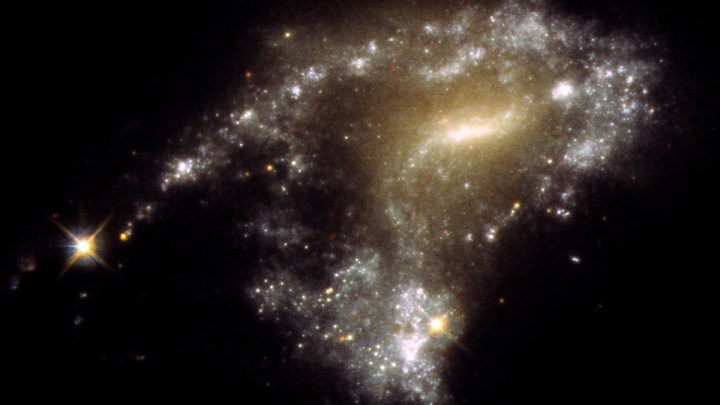When two galaxies collide, the results can be destructive, with one of the galaxies ending up ripped apart, but it can also be constructive too. In the swirling masses of gas and dust pulled around by the gravitational forces of interacting galaxies, there can be bursts of star formation, creating new generations of stars. The Hubble Space Telescope recently captured one such hotbed of star formation in galaxy AM 1054-325, which has been distorted into an unusual shape due to the gravitational tugging of a nearby galaxy.

The S-shape of this galaxy has created a long trail, called a tidal tail, which is thousands of light-years long and where millions of new stars are being born. Researchers have studied 12 interacting galaxies to discover a total of 435 clusters of new stars, with each cluster hosting as many as 1 million baby stars.
“It’s a surprise to see lots of the young objects in the tails. It tells us a lot about cluster formation efficiency,” said lead author Michael Rodruck of Randolph-Macon College in Virginia in a statement. “With tidal tails, you will build up new generations of stars that otherwise might not have existed.”
The study combined new observations from Hubble with older archival data to work out both the ages and masses of star clusters in these tidal tails. The biggest surprise was that the clusters are very young, at just 10 million years old. However, it is uncertain whether these clusters will survive for long. They could glom together in a group and form globular star clusters, or they could stay with the gravitational pull of the original galaxy and form a halo around it. Individual stars may even detach from the structure entirely and become lonely single intergalactic stars.
“These observations tell us how stars form and what regulates those processes. This knowledge is critical in understanding how stars in our own galaxy were formed,” said researcher Sanchayeeta Borthakur of Arizona State University.
The research is published in the Monthly Notices of the Royal Astronomical Society.



